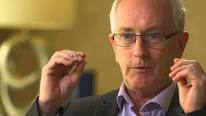Changes in technology, politics and regulations are converging to bring new changes to the financial industry. And in a rare move, all of these present new benefits to average investors.
What makes these changes noteworthy are that they are forcing the very conservative, often anti-investor financial services industry, to essentially give investors more control over their investments and to access cheaper, more easy-to-understand products.
Here are six advances that will benefit individual investors now and in the years ahead.
1. The Rise of Robo-Advisors
The combination of cheaper more powerful technology combined with sophisticated analytics has created a new, investor-friendly type of financial advisors called robo-advisors.
So what is a robo-advisor?
It’s a catchy name for an online wealth management service that provides automated, algorithm-based portfolio management advice without the use of human financial planners. These largely automated systems are becoming more popular because they deliver the same portfolio suggestion a human advisor would do and can choose from a large array of stock and bond investments at a lower cost.
Vanguard, the leader in passive, low-cost index funds, developed its own hybrid robo-adviser, Personal Advisor Services, which had $31 billion in assets in January 2016, according to personal finance columnist Erin Arvedlund of the Philadelphia Inquirer.
Other large robo-advisors in the industry are Charles Schwab’s Intelligent Portfolios, launched in 2015. As of January 2016, Schwab’s robo-adviser assets stood at $5.3 billion. Not to miss the trend, Fidelity Investments is scheduled to launch a new passive fund-ETF portfolio in May or June 2016. Its main feature will be lower fees and customized portfolios. A list of other highly-technological, low cost robo-advisors, including Betterment and Wealthfront, can be found here.
2. Renewed Interest in Passive Investing
A corollary about the rise in robo-investing is that it acknowledged the importance of passive investing as a strategy, combined with exchange-traded funds (ETFs).
Numerous academic studies going back decades have failed to prove the cost-performance-risk benefits of active management, much to the delight of John Bogle, who helped develop and promote the indexing strategy for Vanguard.
Another problem is that up to one-third of active fund managers who charge shareholders for active management have been found to be “closet indexers,” which means they are investing in stocks or ETFs to mimic and index and then seeking to add outperformance by carefully choosing stocks. This is enhanced indexing, distinct from active management, and should not cost investors the same as actively–managed funds.
So what makes passive investing attractive?
Basically, it is due to the structure and goal of indexing. In practice, this means that passive investing (as opposed to actively choosing stocks or an index ETF (exchange traded fund) that will outperform and increase in value over time creates a portfolio of stocks designed to deliver the performance of a specific index. This portfolio is built because, on average, all funds together can only deliver the return of the market. This includes stocks that gain and lose, thus mirroring the performance of the entire index.
Another key reason why index funds outperform is due to their cost structure. This can be found by comparing the gross returns of active versus passive funds. Actively-managed fund returns suffer from the costs of higher management fees needed to cover research costs, higher trading costs as the managers re-direct their portfolios in the hopes of beating the market, and high sales costs. Over time, these costs add to the total expense ratios of actively-managed funds and make it more difficult to beat an index.
In contrast, passive (index) funds eliminate or better manage many of those costs, so a passive fund can start from 0.15% upwards, while some index ETFs can be even cheaper.
A critical variable is performance from many studies is cost or a fund’s total expense ratio. This is why investors have to know how their mutual fund company sells their funds since these costs are passed onto investors in the form of the fund’s total expense ratio.
When a fund employs a national sales force comprised of mutual fund wholesalers, for instance, their internal support staffs, key account, project managers, and other financial rep customer contacts, are all paid for by the fund distributor. This adds to the fund’s total costs, which are then ultimately paid by shareholders. “In fact, low costs have been proven to be a more reliable indicator of performance that past returns,” according to Paula Niall, author of “Investment: Dispelling the active management myth.”
The bottom line is that more investors are becoming more informed about alternatives to more expensive, actively-managed mutual funds that do not deliver on their promise of beating benchmark returns.
Active managers now say that non-trending marketing, greater volatility and the risks of “headline,” or short-term events, have made their jobs more difficult. This is understandable and offers some hope that some active managers have valid strategies that deserve the attention of investors.
There is even a good marketing opportunity for active managers to adopt a sliding performance compensation scale to attract new investors. This hurdle rate used in hedge funds has a role in active funds. Investors would pay for performance, but it is reasonable to expect them to pay less, or nothing at all, if a manager fails to beat a benchmark.
3. New DOL Conflict-of-Interest Disclosures Benefit Investors
In April 2016, after six years of financial services industry opposition, the US Department of Labor (DOL) implemented the first phase of its long-awaited regulation that investment advisers adhere to a fiduciary duty. This standard requires that brokers act in the best interest of their clients and disclose all material conflicts-of-interest. Broker-dealers operate under a suitability rule in which they are required to ensure that investments a client’s needs, timeline and risk appetite. Full implementation of the rule will happen in January 2018.
Conflicts-of-interest in the advisory business cost investors about $17 billion annually, and possibly up to twice that amount, according to a White House study. This $17 billion represents about 1% of all retirement savings. While the financial industry continues to oppose the new rule (House Speaker Paul Ryan and most Republicans oppose the regulation), informing uniformed investors about better-suited, often cheaper investments should create returns that go right to an investor’s bottom line.
The reason is that fees and expenses are the main variables that all investors can control all the time. The other important variable is savings. So while lower fees and expenses directly benefit investors, the financial industry opposes the rules since it would impact their commission and sales-based business model. The new rule means financial reps have to disclose their motives for selling a specific product over another.
The new regulation also makes two important points: regulation is beneficial to markets and individuals, and what’s good for investors often is opposed by the financial services industry.
4. New Scrutiny on the Failures of Unregulated Capitalism
Unregulated capitalism has created global problems among many developed western nations. Public discussions about class inequality, wage stagnation, beneficial tax treatment for the wealth and large corporations, pay gaps between men and women, unaffordable housing and inordinate debt loads for students are now being discussed globally, as well as in the current presidential campaigns by Democrats. While finding solutions to these problems will dominate policymakers for years to come, the fact that they are being publicly discussed by the electorate, and often not by the mainstream media, represents a shift in public awareness.
5. New Efforts to Bring Back Fiscal and Monetary Policy in Washington
Only a decade ago, economic policy discussions addressed the issues of fiscal and monetary policies. The monetary policies were conducted by the Federal Reserve, while Congress debated the merits of various fiscal policies designed to stimulate the economy and create jobs. Then, Congress took action.
Those days are long gone as conservative Republicans have stymied Congress and pushed their belief that the federal government’s public spending programs are the enemy to their new conservative agenda.
The current presidential election campaign has highlighted the current dis-functional Congress, but it needs to do more to show that Fed policy alone was never designed to create jobs. Voters should elect people in Congress who will reject conservative, anti-government doctrines in favor of those who want to create jobs.
6. Growing Awareness About the Failure of Neo-Classical Economists
While this may sound esoteric, the failures of unregulated capitalism have forced some academic economists to examine why capitalism has created huge wealth gaps, as opposed to creating prosperity. While mainstream academic, Federal Reserve, corporate and think-tank economists try to occupy the commanding heights of economic prediction, the reality is that they all missed calling the Great Recession that began in 2007 and continues to linger today.
Why?
Steve Keen, an Australian non-orthodox economist, has noted that neo-classical (aka neo-liberal) economists advocate individual gain and laissez faire capitalism at the expense of society. These policies have destroyed wealth and created income inequality worldwide. This category of neo-liberal economists, including Libertarian Alan Greenspan, ignored the rising level of private debt that was building in 2007. This increased leverage and drove up asset prices and encouraged more borrowing. The first time this reached the breaking point was in 1987, followed again by housing complex derivatives speculation that peaked in 2007. Keen said Greenspan ignored the warnings of the impending bubble voiced by Bill White, a Bank of International Settlement’s economist who predicted the 2007 Crash. Greenspan ignored the warning because this economic approach differed from Greenspan’s neo-liberal classical training and because Wall Street assured him their complex derivatives bets were safe.
Instead, better explanations of economic events come from theories proposed by non-neo-liberal economists, such as Keen, Wayne Godley and Hyman Minsky. In his books and speeches, Keen opposes the undisputed dominance of the financial sector, which has created an unsustainable level of personal debt and rampant speculation that is artificially driving up asset prices. He also has identified the “bad thinking” in university economics departments that teach outmoded or inaccurate theories that do not acknowledge the failures of free markets, the dominance of the financial industry and its creation of a “private debt bubble.”
While the public often ignores economic debates, it’s noteworthy when some economists begin to question the foundation of their own profession, especially one which is so fundamental to our daily lives.











